 |
|
| Nellis Air Force Base
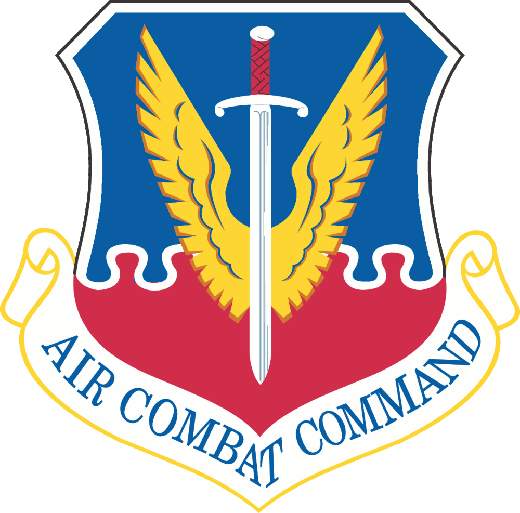
Air Combat Command
|
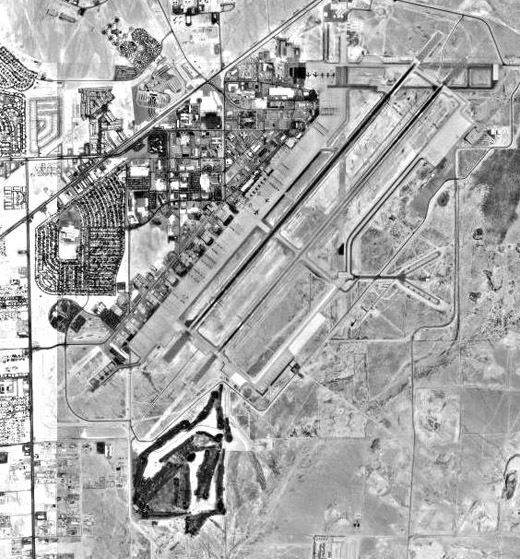 |
| USGS aerial image - June 9, 1994 |
| IATA: LSV – ICAO: KLSV – FAA LID: LSV |
| Summary |
| Airport type |
Military: Air Force Base |
| Owner |
United States Air Force |
| Operator |
Air Combat Command |
| Location |
Clark County, near North Las Vegas, Nevada |
| Built |
1941 |
| Occupants |
99th Air Base Wing, 57th Air Base Wing |
| Elevation AMSL |
1,867 ft / 569 m |
| Coordinates |
36°14′10″N 115°02′03″W / 36.23611°N 115.03417°W / 36.23611; -115.03417 |
| Website |
www.nellis.af.mil |
| Runways |
| Direction |
Length |
Surface |
| ft |
m |
| 03L/21R |
10,123 |
3,085 |
Concrete |
| 03R/21L |
10,055 |
3,065 |
Concrete |
| Sources: official site and FAA |
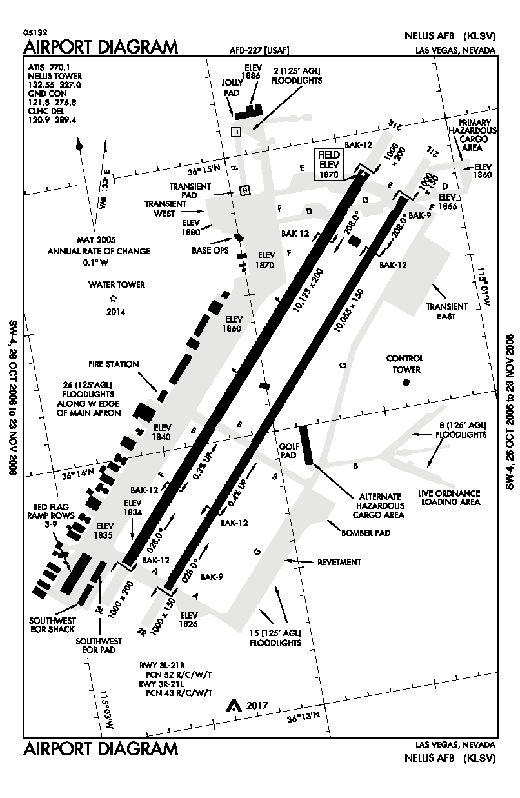 | |
FAA airport diagram |
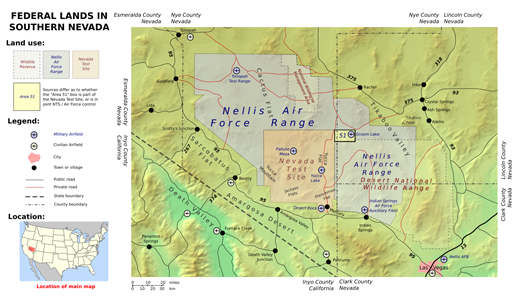 | |
Map showing the locations of Nellis AFB and the NTTR |
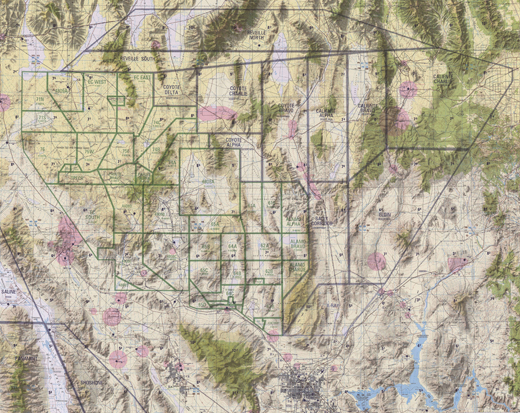 | |
Military JOG (AIR) chart depicting the Nellis AFB TTR and ranges. |
Nellis Air Force Base (IATA: LSV, ICAO: KLSV, FAA LID: LSV) is a United States Air Force base located in North Las Vegas, Nevada. It is seven nautical miles (13 km) northeast of the central business district of Las Vegas. It was named in honor of P-47 pilot 1st Lieutenant William Harrell Nellis, who was killed in WWII during the Battle of the Bulge. Overview
An installation of the Air Combat Command (ACC), Nellis is the location of the United States Air Force Warfare Center and is a major training location for both U.S. and foreign military aircrews. The base is named for William Harrell Nellis, a Las Vegas resident and Army Air Force P-47 pilot who died in action during the Battle of the Bulge.
The main base covers approximately 11,300 acres (4,600 ha). Sixty-three percent of it is undeveloped, while the remaining area is either paved or contains structures.
The base consists of three major functional areas.
- Area I includes the airfield and most of the mission support functions.
- Area II is east of Area I and contains the munitions area.
- Area III is across Las Vegas Boulevard from Area I. It contains housing, Mike O'Callaghan Federal Hospital, and open space.
The associated Nevada Test and Training Range is located to the west in Nye and several other counties.
Units
As a result of its varied roles, Nellis AFB is home to more squadrons than any other Air Force Base.
United States Air Force Warfare Center
- 53d Wing (Eglin Air Force Base, Florida; 53rd Wing has 17 subordinate unit locations nationwide)
- 53d Test and Evaluation Group
- 422d Test and Evaluation Squadron
- 53d Test Management Group Eglin Air Force Base
- 59th Test and Evaluation Squadron
- 57th Wing
- 57th Operations Group
- 57th Operations Support Squadron
- 6th Combat Training Squadron
- 12th Combat Training Squadron
- 57th Operations Support Squadron
- 414th Combat Training Squadron
- 548th Combat Training Squadron
- 549th Combat Training Squadron
- 57th Adversary Tactics Group
- 64th Aggressor Squadron
- 65th Aggressor Squadron
- 507th Combat Training Squadron
- 547th Intelligence Squadron (IS)
- 57th Maintenance Group
- 57th Aircraft Maintenance Squadron
- 57th Component Maintenance Squadron
- 57th Equipment Maintenance Squadron
- USAF Advanced Maintenance and Munitions Officer School
- USAF Weapons School
- USAF Air Demonstration Squadron (The Thunderbirds)
- 98th Range Wing (formerly 554th Range Group)
- 99th Air Base Wing responsible for the operation of Nellis and Creech Air Force Bases (formerly 554th Operations Support Wing)
- 99th Civil Engineer Squadron (formerly 554th Red Horse Squadron and 554th Civil Engineering Squadron)
- 99th Communications Squadron
- 99th Comptroller Squadron
- 99th Contracting Squadron
- 99th Mission Support Group (formerly 554th Support Group & 554th Combat Support Group)
- 99th Civil Engineer Squadron (formerly 554th Red Horse Squadron and 554th Civil Engineering Squadron)
- 99th Communications Squadron
- 99th Contracting Squadron
- 99th Logistics Readiness Squadron
- 99th Mission Support Squadron
- 99th Services Squadron
- 99th Medical Group (formerly 554th Medical Group & formerly under 554th Combat Support Group)
- 99th Aerospace Medicine Squadron
- 99th Dental Squadron
- 99th Medical Operations Squadron
- 99th Medical Support Squadron
- Surgical Operations Squadron
- Inpatient Operations Squadron
- 99th Security Forces Group (all security forces formally under 554th Combat Support Group)
- 99th Ground Combat Training Squadron (formerly 554th Combat Arms Training and Maintenance (CATM))
- 99th Security Forces Squadron (formerly 554th Security Police Squadron - 554th SPS)
- 99th Security Support Squadron (formerly 554th Security Support Squadron, protecting Area 2 (nuclear weapons storage area or "WSA"), just north by northeast of Nellis AFB)
- 99th Services Squadron
Other units
- 58th Rescue Squadron (58 RQS), subordinate unit of the 23d Wing
- 66th Rescue Squadron (66 RQS), subordinate unit of the 23d Wing
Area 2
Area 2 is widely regarded as one of the largest weapons storage sites in the United States. When atomic testing was occurring at the Nevada test Site, Area 2 was used for the storage of the weapons.
History
Major commands to which assigned
- West Coast Air Corps Training Center, April 1941
-
- USAAC Flexible Gunnery School, March 1941
- Air Corps Flying Training Command, January 23, 1942
- Redesignated: Army Air Force Training Command, March 15, 1942
- Redesignated: Air Training Command, July 1, 1946
- Las Vegas Army Airfield was placed in caretaker status, August 28, 1946, and inactivated on December 31, 1946. It was assigned as a subbase of Mather AAF, California, between August 30, 1947 – March 31, 1948. It was reactivated on April 1, 1948 and assigned as a subbase of Williams AFB, Arizona, April 1, 1948 – October 1, 1950 when it was returned to primary installation status.
- Tactical Air Command, July 1, 1958
- Air Combat Command, June 1, 1992 – present
Major units assignedReferences for history introduction, major commands and major units
Operational history
The history of the base began with a survey in October 1940 by Major David M. Schlatter of the Army Air Corps, who examined various sites in the Southwest looking for a location for an aerial gunnery school. Las Vegas was attractive for its clear weather and year-round flying, and the then-impoverished city was eager for a military base. On January 2, 1941 the city bought an airstrip run by Western Air Express and leased it to the Air Corps three days later, the plan being to use the strip for both military and civilian aircraft. One fallout of the opening of the base was the closing of Block 16 brothels in Las Vegas.
Construction of the "Las Vegas Army Air Field" began in March 1941; the first commander, Colonel Martinus Stenseth, arrived in May. Much of the early gunnery training, originally set to begin in September, but not underway until January 1942, used machine guns mounted in trucks and targets on railroad cars, used to accustom students to firing at a moving target. World War II made the base's mission especially urgent, and by the end of 1942, 9,117 gunners had graduated, with aircraft in use including Martin B-10s, AT-6s, A-33s, B-17 Flying Fortresses, B-24 Liberators, and B-26 Marauders. Remains of Clay Pigeons from these guns still exist today in the desert north of Las Vegas. Many pieces of the destroyed aerial drone targets litter the hillside north of the gunnery range and can be seen in town when the sun reflects off of them.
At the height of training in 1943 and 1944, over 15,000 men and women were at the base. Actors Ronald Reagan and Burgess Meredith came to help produce the film Rear Gunner. Much of the training was for B-17 gunners, then at the beginning of 1945 emphasis shifted to the B-29 Superfortress. An innovation was the use of a specially-designed target aircraft, the RP-63, which was sufficiently armored to be shot at with frangible bullets. At war's end, the school had trained more than 55,000 gunners including more than 45,000 B-17 gunners, and more than 3,000 for the B-29.
The gunnery school closed in September 1945, and the base itself was officially inactivated in January 1947. It was reactivated by the newly-created United States Air Force in March 1948, who organized an advanced single-engine school. The first Air Force Gunnery Meet was held at the base on May 2, 1949, with competitors from 14 Air Force units, flying both prop and jet aircraft.
The base was renamed Nellis Air Force Base on April 30, 1950 from Las Vegas Air Force Base. Shortly thereafter the base was again needed to prepare pilots for the Korean War, first with P-51 Mustang training, and then with F-80s and F-86 Sabres. The base also became a part of testing programs for new aircraft.
The Air Force air demonstration squadron, the Thunderbirds came to Nellis on June 1, 1956, along with F-100 Super Sabres. The F-105 Thunderchief arrived in 1960; in June 1962, two crashes in one day at Nellis forced the grounding of all F-105s for evaluation and modifications. The last USAF F-100s were retired in 1969, although the aircraft continued in use in the Air National Guard into the 1970s.
On September 1, 1966, the Tactical Fighter Weapons Center was established to unify the research and training functions of the base and assigned to the 12th Air Force.
In 1969, the 57th Fighter Wing was activated to start then-named USAF Fighter Weapons School. Now known as the USAF Weapons School, it provides to this day graduate level training on all weapons systems that a USAF officer would be expected to utilize. This includes air to air combat with both gun and missiles and air to ground combat. The graduates are also given basic courses in fighter system maintenance in particular how to tell if a system is installed wrong during the preflight walk around.
This school was created in response to lessons learned from air to air combat in World War II, and is similar to the U.S. Navy Fighter Weapons School.
Housing shortages had been a perennial problem for the base, but in the early 1970s Las Vegas' growth resulted in a new problem, with residential areas beginning to encroach on the flight paths. Although the problem was handled by modifying operations, the issue continues to plague both Nellis and Las Vegas planners.
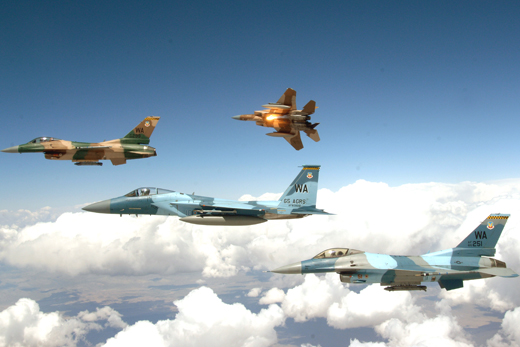 | |
U.S. Air Force F-15 Eagles and F-16 Fighting Falcons fly above the Nevada Test and Training Ranges on Nellis Air Force Base, Nev., June 5, 2008. The jets are assigned to the 64th and 65th Aggressor squadrons stationed on Nellis Air Force Base. |
Lessons from the Vietnam War led to the establishment of Red Flag exercises at Nellis. Pilots from the 64th Aggressor Squadron now fly F-16s according to the doctrines of possible enemy forces, and engaging in mock dogfights with visiting squadrons from the United States and countries friendly to the United States. The 65th Aggressor Squadron was activated and flies the F-15 in its first adversary role.
Continuing with the trend of competitive training, in 1981 the ten-day Gunsmoke '81 was the first gunnery meet to be held since 1962, and featured teams from all over the world. The event would continue to be held every two years. The 1980s were a busy time for Nellis, with a dozen types of aircraft being supported, as well as visiting aircraft from the Army, Navy, Marine Corps, and foreign nations. In 1988, the F-117 Nighthawk was unveiled here; it had been developed and tested at the Tonopah Test Range, a smaller facility in the northern part of the nearby Nellis Air Force Range in the desert northwest of Las Vegas.
The Indian Springs Air Force Auxiliary Airstrip was a part of Nellis. While little known, it was home to the 11th, 15th, and 17th Reconnaissance Squadrons which operate the Predator RQ-1, MQ-1 and MQ-9 Unmanned Aerial Vehicles (UAV). On June 20, 2005 the field was renamed Creech Air Force Base.
On January 14, 2003 the first production F-22A Raptor was delivered to the base. Nellis Air Force Base was selected as the location for the F-22 Force Development Evaluation program and Weapons School for the reason of weather similar to that in Iraq and Afghanistan. On December 21, 2004 one F-22A crashed on takeoff, marking the first accident at the base since March 1996 and the first accident of an F-22 since 1992. As of July 2008, there were 12 Raptors assigned to the 422d Test and Evaluation Squadron for various development and evaluation missions.
The Unmanned Aerial Vehicle Center for Excellence was established at Creech Air Force Base in 2005.
On November 14, 2006 the Air Force declassified information regarding an American-manned Russian MiG unit used in training at Nellis from the late 1970s to early 1980s. This unit was known as the Red Eagles and used MiG-17s, MiG-21s and MiG-23s to simulate combat to test the capabilities of the F-4 Phantoms, F-15 Eagles and F-16 Fighting Falcons.
On April 23, 2007 construction was started on a 140 acre, 70,000 solar panel power generation system. The installation on the west side of the base was completed in December 2007. The 14 megawatt system is expected to provide 25% of the base's power requirements. On May 27, 2009 President Barack Obama toured the photovoltaic array during a visit to the base where he promoted the Recovery Act of 2009 and renewable energy.
Geography
According to the United States Census Bureau, the base has a total area of 3.1 sq mi (8.0 km), all of it land. It is also treated as a census-designated place by the United States Census for statistical purposes, and so specific demographic information about residents of the base is compiled. As of 2000, the base had a population of 8,896.
DemographicsAs of the census of 2000, there were 8,896 people, 2,873 households, and 2,146 families residing in the base. The population density was 2,895.9 people per square mile (1,118.8/km²). There were 3,040 housing units at an average density of 989.6/sq mi (382.3/km²). The racial makeup of the base was 68.46% White, 14.34% African American, 1.37% Native American, 4.97% Asian, 0.73% Pacific Islander, 4.90% from other races, and 5.23% from two or more races. Hispanic or Latino of any race were 11.72% of the population.
There were 2,873 households out of which 52.6% had children under the age of 18 living with them, 61.5% were married couples living together, 7.7% had a female householder with no husband present, and 25.3% were non-families. 17.9% of all households were made up of individuals and 1.1% had someone living alone who was 65 years of age or older. The average household size was 2.91 and the average family size was 3.36.
In the base the population was spread out with 33.4% under the age of 18, 19.7% from 18 to 24, 38.5% from 25 to 44, 7.1% from 45 to 64, and 1.2% who were 65 years of age or older. The median age was 24 years. For every 100 females there were 117.9 males. For every 100 females age 18 and over, there were 124.8 males.
The median income for a household in the base was $33,118, and the median income for a family was $34,307. Males had a median income of $25,551 versus $19,210 for females. The per capita income for the base was $13,601. About 10.0% of families and 11.1% of the population were below the poverty line, including 15.4% of those under age 18 and 16.1% of those age 65 or over.
In popular culture and media
- In Stephen King's The Stand, one character journeys to Nellis AFB.
- The base is frequently referenced in books by Dale Brown.
- The 1991 video game Megafortress features training exercises flown out of the base.
- In the 1999 video game Jane's USAF, all training missions are set at Nellis AFB.
- In the 2007 film Transformers, the base showed a Special Ops team landing in a C-17 Globemaster III, and F-22 Raptors are shown taking off from the base. But in actuality, the base used in the shot is Edwards AFB, California. Holloman AFB, New Mexico was also used in filming the movie.
- In the popular viral video Where the Hell is Matt (2008), Matt Harding can be seen dancing while in freefall at Nellis Air Force Base.
- In 2009, Nellis Air Force Base was featured in an episode of Top Chef; the episode was filmed in the dining facility kitchen and The Thunderbirds hangar.
The above content comes from Wikipedia and is published under free licenses – click here to read more.
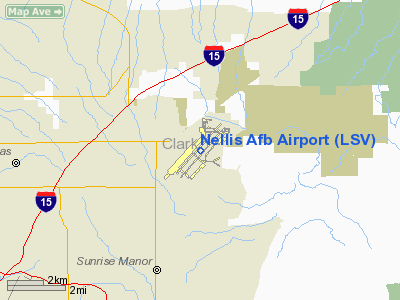
Location & QuickFacts
| FAA Information Effective: | 2008-09-25 |
| Airport Identifier: | LSV |
| Airport Status: | Operational |
| Longitude/Latitude: | 115-02-03.3100W/36-14-10.3100N
-115.034253/36.236197 (Estimated) |
| Elevation: | 1867 ft / 569.06 m (Estimated) |
| Land: | 0 acres |
| From nearest city: | 7 nautical miles NE of Las Vegas, NV |
| Location: | Clark County, NV |
| Magnetic Variation: | 14E (1985) |
Owner & Manager
| Ownership: | Air Force owned |
| Owner: | Usaf |
| Address: | Nellis Afb
Las Vegas, NV 89110 |
| Manager: | Chief Of Afld Management |
| Address: | Nellis Afb
Las Vegas, NV 89110 |
| Phone number: | 702-643-2227
4359. |
Airport Operations and Facilities
| Airport Use: | Private |
| Wind indicator: | Yes |
| Segmented Circle: | No |
| Control Tower: | Yes |
| Lighting Schedule: | DUSK-DAWN |
| Beacon Color: | Clear-Green (lighted land airport) |
| Landing fee charge: | No |
| Sectional chart: | Las Vegas |
| Region: | AWP - Western-Pacific |
| Boundary ARTCC: | ZLA - Los Angeles |
| Tie-in FSS: | RNO - Reno |
| FSS on Airport: | No |
| FSS Toll Free: | 1-800-WX-BRIEF |
| NOTAMs Facility: | LSV (NOTAM-d service avaliable) |
Airport Services
| Fuel available: | B+ |
| Airframe Repair: | MAJOR |
| Power Plant Repair: | MAJOR |
| Bottled Oxygen: | NONE |
| Bulk Oxygen: | HIGH/LOW |
Runway Information
Runway 03L/21R
| Dimension: | 10123 x 200 ft / 3085.5 x 61.0 m |
| Surface: | CONC, |
| Pavement Class: | 43 /R/C/W/T |
| Weight Limit: | Single wheel: 60000 lbs.
Dual wheel: 160000 lbs.
Dual tandem wheel: 265000 lbs.
Dual dual tandem wheel: 650000 lbs. |
| Edge Lights: | High |
| |
Runway 03L |
Runway 21R |
| Longitude: | 115-02-48.6500W | 115-01-27.6000W |
| Latitude: | 36-13-35.8900N | 36-14-51.4000N |
| Elevation: | 1833.00 ft | 1868.00 ft |
| Alignment: | 41 | 127 |
| Traffic Pattern: | Left | Right |
| Markings: | Precision instrument, Good Condition | Precision instrument, Good Condition |
| Arresting: | BAK12 | BAK12 |
| VASI: | non-specific system | non-specific system |
| Visual Glide Angle: | 3.00° | 3.00° |
| Approach lights: | ALSF1 | ALSF1 |
| Runway End Identifier: | No | No |
| Centerline Lights: | No | No |
| Touchdown Lights: | No | No |
|
Runway 03R/21L
| Dimension: | 10055 x 150 ft / 3064.8 x 45.7 m |
| Surface: | CONC, |
| Pavement Class: | 52 /R/C/W/T |
| Weight Limit: | Single wheel: 60000 lbs.
Dual wheel: 160000 lbs.
Dual tandem wheel: 265000 lbs.
Dual dual tandem wheel: 650000 lbs. |
| Edge Lights: | High |
| |
Runway 03R |
Runway 21L |
| Longitude: | 115-02-39.1500W | 115-01-18.6500W |
| Latitude: | 36-13-29.3900N | 36-14-44.3900N |
| Elevation: | 1825.00 ft | 1864.00 ft |
| Alignment: | 41 | 127 |
| ILS Type: | | LOC/GS
|
| Traffic Pattern: | Left | Right |
| Markings: | Precision instrument, Good Condition | Precision instrument, Good Condition |
| Arresting: | BAK12 | BAK12 |
| VASI: | non-specific system | non-specific system |
| Visual Glide Angle: | 3.00° | 3.00° |
| RVR Equipment: | touchdown | |
| Approach lights: | ALSF1 | ALSF1 |
| Runway End Identifier: | No | No |
| Centerline Lights: | No | No |
| Touchdown Lights: | No | No |
|
Radio Navigation Aids
| ID |
Type |
Name |
Ch |
Freq |
Var |
Dist |
| LSV | TACAN | Nellis | 012X | | 15E | 0.7 nm |
| INS | TACAN | Indian Springs | 067X | | 15E | 37.2 nm |
| LAS | VORTAC | Las Vegas | 116X | 116.90 | 15E | 11.2 nm |
| BLD | VORTAC | Boulder City | 114X | 116.70 | 15E | 16.7 nm |
| MMM | VORTAC | Mormon Mesa | 090X | 114.30 | 16E | 48.6 nm |
| VGT | VOT | North Las Vegas | | 108.20 | | 8.3 nm |
Remarks
- A-GEAR: RWY 03L BAK-12(B) (40'OVRN).
- MISC: RSRS WILL BE APPLIEDTO BASEASGN/DEPLOYED ACFT IAW NAFBI 11-250SEE (HTTPS://WWWMIL.NELLIS.AF.MIL/UNITS/99CS/SCS/NAFBI%2011-250.PDF).
- SERVICE- LGT: ALL RWY THLD LGT GATED. RWY 21L PAPI RRP AND PAR/ILS RPI NOT COINCIDENTAL.
- A-GEAR: ALL BAK-12B AND BAK-9, BOTH RWY, EXTN AND IN RAISED POSN, RQR 15 MIN PN FOR REMOVAL.
- JASU - NO STARTER UNIT OR STARTING CAPABILITY FOR F4B, F4J ACFT. NO STARTER PROBE FOR USN ACFT. 2(MA-1A).
- FUEL: J8. FUEL WILL NOT BE ORDERED TIL ACFT IS PRK.
- FLUID: W-EXP 2-3 HR DELAY. SP PRESAIR LHOX LOX
- OIL: O-123-128-132-133-148-156 SOAP.
- TRAN ALERT: OPR 1430-0630Z++, NO QUICK TURN FRI-SUN. ALL DEP MUST BE PRIOR 1900Z++; ALL ARR MUST LAND AFTER 2100Z++ ON WKEND AND HOL. NO MIL FLEET SVC AVBL, LTD TRAN SVC AVBL. NO TRAN ACFT CAN ARR/DEP PRIOR TO 1430Z++ AND MUST ARR/DEP NO LATER THAN 0600Z++.
- TRAN ALERT: FLEET SVC IS AVBL FR SIGNATURE FLT SUPPORT C702-261-3583/3529, 48 HR PN RQR. PROGRESSIVE TAXI AVBL.
- SEE FLIP AP/1 SUPPLEMENTARY ARPT RMK.
- RSTD: PPR ALL EXC DV CODE 7 OR ABV AND EMERG AIREVAC, PPR ISSUED 1430-0630Z++. RON REQ GOOD FOR ONE NGT ONLY. ACFT MUST ADHERE TO PPR ARR BLOCK +/- 60 MIN OF SKED LDG. EXTV LARGE FORCE EXER (LFE) ACT.
- RSTD: PPR ARR NOT AUTH DUR RED FLAG (RF) OR LFE LAUNCH/RECOVERY PERIOD - CK NOTAM FOR DATE/TIME. NO PPR ARR DUR NGT RF/LFE OPR. MULTI APCH NOT AUTH DUR RF/LFE OR AFTER OFFL SS UNLESS APV BY 57 WG SOF. PPR'S MAY BE OBTAINED UP TO 7 DAYS PRIOR TO PLANNED ARR.
- RSTD: REQ FOR ADDN ACFT FR A BASE THAT HAS MET THE MAX ALLOWED (4) WILL BE CONSIDERED 3 DAYS PRIOR TO SKED ARR, SUPPORT AND SPACE PERMS. DUR RF/LFE PERIODS, PPR'S MAY BE REQ UP TO 7 DAYS PRIOR TO ARR BUT ISSUED NO EARLIER THAN 24 HR PRIOR TO PLANNED ARR.
- RSTD: ACFT WITH VIP 7 OR HI CTC PTD WHEN 100NM OUT.
- RSTD: OPR RSTD DUR BIRD WATCH COND MODERATE (TKOF OR LDG PERMS ONLY WHEN DEP AND ARR AVOID IDENT BIRD ACT, NO LCL IFR/VFR TFC PAT ACT) AND SEVERE (TKOF AND LDG PROH WO OG/CC OR DESIGNATED OFFL APVL).
- CAUTION - STEEPLY RISING TERRAIN S AND E OF CNTRLINE RWY 03R-21L. RWY 03L-21R HAS HI POTENTIAL FOR HYDROPLANING. 200' CRANES N OF DEP END RWY 03L. ACFT TAXIING ON TWY D BTN TWY F AND RWY 21R USE CAUTION, 4' 8'' HI DIST REMAINING MRK LCTD 125' N TWY D CNTRLINE.
- TFC PAT: ACFT DEP WILL NOT CLIMB ABV 3000' TIL PAST THE DEP END OF RWY.
- NS ABTMT: ACC QUIET HR POLICY IN EFF 0630-1400Z++.
- MISC: FIRST 1320' RWY 21R AND FIRST 920' RWY 03L GROOVED CONCRETE. MID 7879' RWY 03L-21R CNTR 80' CONCRETE, BALANCE ASPHALT. ACFT DEP ON RADAR VECTORS MUST MAINT 300' PER NM MIN CLIMB.
- MISC: E SIDE 9000'-1000' DIST REMAINING MRK RWY 21L NOT AVBL. TRAN ACFT SHALL COMMUNICATE WITH NELLIS ATC FAC ON UHF TO THE MAX EXTENT POSSIBLE DUE TO HVY CONCENTRATION OF ACFT IN THE VFR PAT.
- RSTD: PPR FOR TRAN FTR/DV ACFT CTC AM OPS DSN 682-4600/01, C702-652-4600. PPR FOR EXER, DEPLOYMENT, C130 AND LARGER ACFT CTC NELLIS SUPPORT CENTER DSN 682-2713/5250 1430-0030Z++ MON-FRI.
- RSTD: SUN AND HOL TFC EXP ARR FR N, DEP N WINDS PERM WITH TFC PAT TOWARDS E (SUNRISE MT).
- BEARING STRENGTH: RY 03L/21R - S70 T150 ST175 TT360 TDT 840.
- BEARING STRENGTH: RY 03R/21L - S130 T225 ST175 TT280 TDT800.
- MISC: NO CLASSIFIED MATERIAL STORAGE AVAILABLE AT AM OPS. ALL CLASSIFIED MUST BE STORED IN THE NELLIS AFB COMMAND POST.
- MISC: BUILDINGS (AND FLOODLIGHTS AT NIGHT) BLOCK THE WEATHER FORECASTER'S VIEW OF THE APPROACH END OF RUNWAY 03.
- SERVICE-LGT: ALL SFL ON 21L 1.5 FT TO RIGHT OF EXTENDED CENTERLINE.
- MISC (#1 OF 2): WX OPR 0700Z MON THRU 2300Z++ FRI; CLSD WKND AND HOL. WX OBSN VIEW OF RWY 03R/L APCH END RSTD BY FLIGHT FAC; OBSN VIEW RSTD FR 190‘-330‘ BY FLIGHTLINE FAC AND BLDGS; NGT OBSN LTD DUE TO HI INTS RAMP LGT.
- MISC (#2 OF 2): WX BRIEF FOR TRAN AIRCREWS BYD NML OPR HR AVBL VIA 25 OWS AT DAVIS MONTHAN AFB DSN: 228-6598/6599, C(520)228-6598/6599.
- RSTD: HOT CARGO PAD UNLIT AND RSTD TO DAYLIGHT/VFR OPS.
- MISC: FOR CSTMS AND AG; CTC NELLIS SUPPORT CENTER FOR C-130 AND LARGER FRAMED ACFT AT DSN 682-5250 OR CTC BASE OPS FOR ALL OTHER ACFT AT DSN 682-4600 24 HOURS PRIOR TO ARRIVAL.
Images and information placed above are from
http://www.airport-data.com/airport/LSV/
We thank them for the data!
| General Info
|
| Country |
United States
|
| State |
NEVADA
|
| FAA ID |
LSV
|
| Latitude |
36-14-10.200N
|
| Longitude |
115-02-03.000W
|
| Elevation |
1868 feet
|
| Near City |
LAS VEGAS
|
We don't guarantee the information is fresh and accurate. The data may
be wrong or outdated.
For more up-to-date information please refer to other sources.
|
 |



